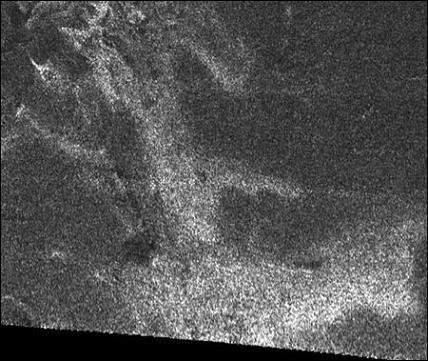The large Saturnian moon Titan may have areas where ice occasionally erupts from the warmer interior of the moon. So claim scientists relying on data transmitted by the Cassini spacecraft

The bright areas may be volcanic ice flow
The large Saturnian moon Titan may have areas where ice occasionally erupts from the warmer interior of the moon. So claim scientists relying on data transmitted by the Cassini spacecraft.
Radar scans taken during Cassini's last approach to Titan on October 26 showed deposits of bright formations on the moon. The mission scientists estimate that these may be flows of frozen liquid. They call the phenomenon cryovolcanic flow.
Water-rich ice may settle below the surface and flow out under pressure. The scientists believe. "It could be the result of the mass or a formation carved by weathering processes. It is too early to say which of the two theories is correct." says Ralph Lorenz, a member of the Cassini radar team and a researcher at the University of Arizona.
"However, it looks very similar to something that leaked along the surface. It may be a certain type of cryo-volcanic flow, something similar to the volcanic eruptions on Earth, but instead of rocks, blocks of ice and water erupt. This is due to the low temperature of the moon's surface. " said.
Temperatures on Titan do not usually exceed the threshold of 179 degrees Celsius below zero. It is estimated that cryo-volcanic flows also exist on the fair moon Ganymede.
The fact that at the southern (lower) end of the artificial image created from the radar readings, there are light areas, in contrast to the rest of the surface, shows that the light surface is above a dark and featureless ground.
These photos are the closest ever taken.
The scientists expressed surprise at the almost complete absence of impact craters on Titan's surface. A possible explanation for this is that the surface is constantly changing in some kind of geological activity. Several theories have been proposed according to which lakes or even oceans of liquid hydrocarbons such as methane and ethane cover the surface of the moon.
As mentioned, the artificial images were produced from the radar photographs taken on October 26, when the Cassini spacecraft made an approach flight to Titan. Titan is covered in a dense atmosphere of orange haze that has hindered all attempts so far to observe the surface below. The image covers an area of about 150 square kilometers in Titan's northern hemisphere. The area has not yet been imaged by Cassini's regular imaging cameras.
